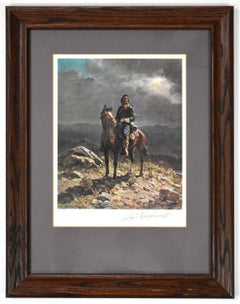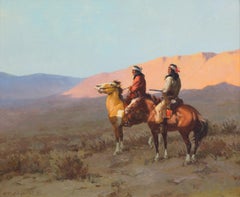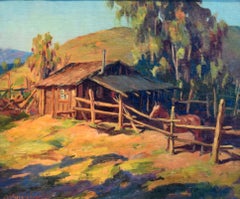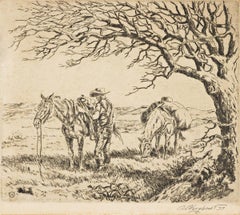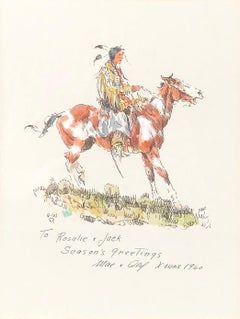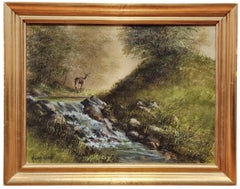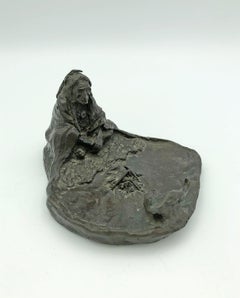Olaf Wieghorst Art
to
2
1
1
1
Overall Width
to
Overall Height
to
5
1
1
1
1
3
2
3
3
2
2
1
1
1
1
1
1
1
1
3
2
1
1
1
5
10,138
2,778
1,375
1,371
2
1
5
Artist: Olaf Wieghorst
"INDIAN ON HORSE" WESTERN NATIVE AMERICAN
By Olaf Wieghorst
Located in San Antonio, TX
Olaf Wieghorst
(1899 - 1988)
California, New York, New Mexico, Arizona, Texas Artist
Image Size: 11 x 8.5
Frame Size: 18.5 x 14.5
Medium: Print
"Indian on Horse...
Category
20th Century Realist Olaf Wieghorst Art
Materials
Archival Pigment
Apaches
By Olaf Wieghorst
Located in Palm Desert, CA
"Apaches" is an oil on canvas painting by Olaf Wieghorst. The painting is signed on the lower left, "O-Wieghorst". The framed piece measures 25 1/2 x 29 3/4 x 2 in.
“When the time comes for me to put away my palette and unsaddle my pony for the last time, I hope that my canvases will in some small measure add to the historical recording of an era, the cowboy, and the great American West.” ~ Olaf Wieghorst
Wieghorst worked with the mounted patrol of the 7th Cavalry Regiment of the United States Cavalry (1920-1922) with occasional interludes as a wrangler on ranches in the western states. Wherever he went, he sketched and painted the Western culture he loved, often selling his work as calendar and magazine illustrations.
His work appeared in Zane Grey...
Category
Early 20th Century American Realist Olaf Wieghorst Art
Materials
Canvas, Oil
$55,000
"Home Corral" Very early Wieghorst California Western Painting awesome colors
By Olaf Wieghorst
Located in San Antonio, TX
Olaf Wieghorst
(1899 - 1988)
California, New York, New Mexico, Arizona, Texas Artist
Image Size: 20 x 24
Frame Size: 29.5 x 33
Medium: oil
1946
"Home Corral" California Olaf Wieghorst
Without a doubt one of if not the most colorful Wieghorst paintings ever done. Signed lower left. Titled on verso. Dated on verso.
In very nice condition. Has been professionally cleaned. Has very fine craquelure in the tree branches and a small spot below the horse that is really only visible if you are extremely close to the painting or with magnification. One of his finest paintings. Also please view my other Wieghorst from the same estate. I have included close up photos as well as photos taken in natural light, spot light and fluorescent lighting.
Olaf Wieghorst
(1899 - 1988)
California, New York, New Mexico, Arizona, Texas Artist
Image Size: 20 x 24
Frame Size: 29.5 x 33
Medium: oil
"Home Corral"
Dated 1946
Biography
Olaf Wieghorst (1899 - 1988)
Born in Viborg, Denmark, Olaf Wieghorst was a child acrobatic performer from the age of nine when he began appearances at Tivoli Theater in Copenhagen and later toured Europe. He also learned horseback riding working on a stock farm, and horses became a major focus of his admiration and later his painting.
In 1918, he arrived in the United States, having worked as a cabin boy on a steamer. He served in the 5th U.S. Cavalry on the Mexican border in the days of Pancho Villa. He later recalled a favorite horse from that period and said that riding through El Paso in 1921, the horse fell on his ankle and broke it. The outfit was heading to Douglas, Arizona, and not wanting to be left behind with his injury, he stayed on the horse which carried him all the way through the New Mexico desert on one of the hottest days of the year. The horse died during the night, having expended all his energy on saving Wieghorst. He later wrote that when the Cavalry discarded the use of horses, "they took the soul out of that great branch of the service" ("Widening Horizons").
He wandered extensively through the West sometimes on horseback, finding work in Arizona and New Mexico as a cowboy. Then he went to New York and served as a mounted policeman until 1944, spending most of his time on a horse named Rhombo patrolling the Central Park bridle paths and saving many people injury from runaway horses. He began painting in his spare time, and he was successful enough that his work was represented by the Grand Central Art Galleries of the Biltmore Hotel.
In 1944, he settled in El Cajon, California. His paintings include cowboys, horses, and Indians in landscape, but there is little if any collectible art of his done during his early days in the West. His primary output came after his return to California when he began painting cowboys and horses extensively. He did numerous horse portraits, spending time on ranches studying their unique personalities. He painted celebrity horses including Roy Rogers' Trigger, Gene Autry's Champion and Tom Morgan's stallion.
He was a large, powerful, handsome, and very personable man.
Source:
Kathleen Wade
Olaf Carl Wieghorst (1899-1988)
He arrived in the U.S. in 1918, joining the U.S.
Cavalry, & patrolled the Mexico border in New Mexico & Arizona . When he mustered out of the army, he drifted, ending up as a wrangler on
the Cunningham Ranch near Alma, New Mexico.
By the mid-twenties,
Wieghorst was in New York City, working as a mounted policeman - his
relationships with the many horses that were a part of his life became
the common denominator of his paintings. Living in California by the end
of WWII, he began a career that spiraled to success, in part due to his
engaging personality.
His paintings have appeared in numerous solo
& retrospective exhibitions including the National Cowboy &
Western Heritage Museum, Oklahoma City (1974), The Tucson Museum of Art,
Arizona (1981), & the San Diego Historical Society, California
(2002).
His work was the subject of the 1970 biography, "Olaf Wieghorst"
by William Reed...
Category
1940s Impressionist Olaf Wieghorst Art
Materials
Oil
Resting The Horses
By Olaf Wieghorst
Located in New York, NY
Etching, 1937. Signed by the artist and dated in pencil lower right margin.
A scarce etching by this important American western artist.
Category
1930s American Realist Olaf Wieghorst Art
Materials
Etching
Season's Greetings 1960 (Brave on Horseback)
By Olaf Wieghorst
Located in Missouri, MO
Olaf Wieghorst (American, 1899-1988)
"Season's Greetings" (Brave on Horseback) 1960
Watercolor/Gouache on Paper
Initialed and Monogramed and Dated
Dedicated: "To Rosalie & Jack, Season's Greetings, Mae & Olaf Xmas 1960"
Site Size: 12 x 9 inches
Framed Size: approx. 22.5 x 18.5 inches
Born in Viborg, Denmark, Olaf Wieghorst was a child acrobatic performer from the age of nine when he began appearances at Tivoli Theater in Copenhagen and later toured Europe. He also learned horseback riding working on a stock farm, and horses became a major focus of his admiration and later his painting.
In 1918, he arrived in the United States, having worked as a cabin boy on a steamer. He served in the 5th U.S. Cavalry on the Mexican border in the days of Pancho Villa...
Category
1960s American Realist Olaf Wieghorst Art
Materials
Paper, Watercolor, Gouache
Price Upon Request
Related Items
"Dragon, " Original Pastel Drawing
By Quang Ho
Located in Denver, CO
"Dragon," by Quang Ho, is a secondary market work with one previous owner. It is signed and dated (1988) on the lower left. The painting comes with it's original frame (measures 50 x...
Category
20th Century American Realist Olaf Wieghorst Art
Materials
Paper, Pastel
A Friend in the Forest, Landscape with Deer
By Richard Weers
Located in Grand Rapids, MI
Richard Weers (American, 1932-2022)
Signed: Richard Weers (Lower, Left)
" A Friend in the Forest "
Oil on Canvas
12" x 16"
Housed in a 1 1/2" Gol...
Category
Late 20th Century American Realist Olaf Wieghorst Art
Materials
Canvas, Oil
Horse at the Golden Hills, California , Impressionist California landscaper.
By Lynn Gertenbach
Located in La Canada Flintridge, CA
Lynn Gertenbach's "Ride at Golden Hills" is a remarkable oil painting that captures a serene moment of a lady riding a horse under a tree, surrounded by lush grass and vibrant scener...
Category
2010s American Impressionist Olaf Wieghorst Art
Materials
Oil
$6,500
H 25 in W 31 in D 2 in
"Texas Hill Country Landscape With Cattle" oil painting of wildflowers, cactus
By Don Warren
Located in Austin, TX
Canvas Size: 12 x 16 in.
Frame Size: 20.5 x 24.5 in.
Signed, lower left: "Don Warren"
A serene, classic, and cheerful scene in the Texas Hill Country by Don Warren. The foreground i...
Category
1970s American Realist Olaf Wieghorst Art
Materials
Canvas, Oil
$975
H 11.25 in W 15.25 in
Antique English Impressionist Signed Dog Portrait Landscape Terrier Oil Painting
Located in Buffalo, NY
Antique English dog portrait landscape oil painting. Oil on board. Framed. Signed. Measuring: 28 by 31 inches overall, and 20 by 24 painting alone. In excellent original condition...
Category
1920s Impressionist Olaf Wieghorst Art
Materials
Canvas, Oil
$1,475
H 28 in W 31 in D 2 in
French art, a country side barn with sheeps.
Located in PARIS, FR
Conditions: In excellent overall conditions, with no repaint under UV light, original canvas and frame. Signed Lower left "Ls Reinhardt". Dimensions with the frame are approximately...
Category
Late 19th Century Impressionist Olaf Wieghorst Art
Materials
Oil
George Boyle Impressionist oil painting, Barbizon School of cows grazing
Located in Harkstead, GB
A superb example of a Barbizon inspired landscape painted by the "Catford Corot" from the late 19th Century. This very striking image shows the artist at the absolute peak of his abi...
Category
Late 19th Century Impressionist Olaf Wieghorst Art
Materials
Oil, Wood Panel
$2,197 Sale Price
20% Off
H 10 in W 14 in D 2 in
Spanish landscape oil on board painting
Located in Sitges, Barcelona
Josep Ventosa Domenech (1897-1982) - Navarcles - Oil on panel
Oil measurements 16x22 cm.
Frame measurements 31x37 cm.
Category
1930s Impressionist Olaf Wieghorst Art
Materials
Oil, Board
$574 Sale Price
40% Off
H 6.3 in W 8.67 in
Landscape with the river. 1992, cardboard, oil, 49x68 cm
By Edgars Vinters
Located in Riga, LV
Landscape with the river. 1992, cardboard, oil, 49x68 cm
Edgars Vinters (1919-2014)
Edgars Vinters is working in oil, watercolor and monotype techniques. He paints landscapes in dif...
Category
1990s Impressionist Olaf Wieghorst Art
Materials
Oil, Cardboard
$684 Sale Price
35% Off
H 19.3 in W 26.78 in D 0.04 in
“In June (Im Juni)” By Julius Paul Junghanns dated "1913"
Located in SANTA FE, NM
“In June (Im Juni)”
Julius Paul Junghanns (German, 1876-1958)
Oil on canvas
Signed and dated “1913,” titled on reverse
18 ½ x 23 1/4 (27 1/4 x 31...
Category
1910s Impressionist Olaf Wieghorst Art
Materials
Canvas, Oil
$4,450 Sale Price
50% Off
H 27.25 in W 31.5 in
Landscape with Man and Goats
Located in London, GB
'Landscape with Man and Goats', gouache on paper, by Raymond Guerrier (circa 1960s). After the artist moved from Paris to the South of France, he started painting landscapes illumina...
Category
1960s Modern Olaf Wieghorst Art
Materials
Paper, Gouache
$824 Sale Price
25% Off
H 20.08 in W 15.36 in
New England Autumnal Bucolic Landscape -- Cows by the Watering Hole 19th Century
Located in Soquel, CA
Gorgeous late 19th Century landscape of cows near watering hole with birch trees and puffy clouds in background by Wesley John Straight (American, 1855 - 1922). Signed lower left corner and on verso. Title "Autumn in New England" on verso lower stretcher bar. Condition: Good; professionally cleaned and restored; minor abrasions repaired and in-painted (see images). Unframed.
Image size: 40"H x 32"W.
Born in Wisconsin on May 20, 1855. Straight appears to have migrated to northern California in the late 1870s. While a resident of San Jose and Grass Valley, he painted scenes of the northern coast and other scenic spots. After moving to southern California in 1912, he lived at the Southern Hotel in San Bernardino until his demise on April 5, 1922. Exhibitions: Delavan Wisconsin County Fair 1874 (painting of the Wisconsin State School for the deaf and countryside), Calif. State Fair, 1880-90, Placer California 1880...
Category
1890s American Impressionist Olaf Wieghorst Art
Materials
Linen, Oil
$2,000 Sale Price
20% Off
H 40 in W 32 in D 1 in
Previously Available Items
Campfire and Buffalo Skull
By Olaf Wieghorst
Located in Missouri, MO
Olaf Carl Wieghorst
"Campfire and Buffalo Skull"
Bronze
approx. 3.5 x 6 x 6 inches
Signed
Born in Viborg, Denmark, Olaf Wieghorst was a child acrobatic ...
Category
Late 19th Century American Realist Olaf Wieghorst Art
Materials
Bronze
"Bronco Buster" SADDLE BRONC RODEO COWBOY WESTERN HORSE RODEO PAINTING
By Olaf Wieghorst
Located in San Antonio, TX
Olaf Wieghorst
(1899 - 1988)
California, New York, New Mexico, Arizona, Texas Artist
Image Size: 10 x 8
Frame Size: 17 x 14
Medium: Watercolor
"Bucking Bronco"
Dated 1946
Biography
Olaf Wieghorst (1899 - 1988)
Born in Viborg, Denmark, Olaf Wieghorst was a child acrobatic performer from the age of nine when he began appearances at Tivoli Theater in Copenhagen and later toured Europe. He also learned horseback riding working on a stock farm, and horses became a major focus of his admiration and later his painting.
In 1918, he arrived in the United States, having worked as a cabin boy on a steamer. He served in the 5th U.S. Cavalry on the Mexican border in the days of Pancho Villa. He later recalled a favorite horse from that period and said that riding through El Paso in 1921, the horse fell on his ankle and broke it. The outfit was heading to Douglas, Arizona, and not wanting to be left behind with his injury, he stayed on the horse which carried him all the way through the New Mexico desert on one of the hottest days of the year. The horse died during the night, having expended all his energy on saving Wieghorst. He later wrote that when the Cavalry discarded the use of horses, "they took the soul out of that great branch of the service" ("Widening Horizons").
He wandered extensively through the West sometimes on horseback, finding work in Arizona and New Mexico as a cowboy. Then he went to New York and served as a mounted policeman until 1944, spending most of his time on a horse named Rhombo patrolling the Central Park bridle paths and saving many people injury from runaway horses. He began painting in his spare time, and he was successful enough that his work was represented by the Grand Central Art Galleries of the Biltmore Hotel.
In 1944, he settled in El Cajon, California. His paintings include cowboys, horses, and Indians in landscape, but there is little if any collectible art of his done during his early days in the West. His primary output came after his return to California when he began painting cowboys and horses extensively. He did numerous horse portraits, spending time on ranches studying their unique personalities. He painted celebrity horses including Roy Rogers' Trigger, Gene Autry's Champion and Tom Morgan's stallion.
He was a large, powerful, handsome, and very personable man.
Source:
Kathleen Wade
Olaf Carl Wieghorst (1899-1988)
He arrived in the U.S. in 1918, joining the U.S.
Cavalry, & patrolled the Mexico border in New Mexico & Arizona . When he mustered out of the army, he drifted, ending up as a wrangler on
the Cunningham Ranch near Alma, New Mexico.
By the mid-twenties,
Wieghorst was in New York City, working as a mounted policeman - his
relationships with the many horses that were a part of his life became
the common denominator of his paintings. Living in California by the end
of WWII, he began a career that spiraled to success, in part due to his
engaging personality.
His paintings have appeared in numerous solo
& retrospective exhibitions including the National Cowboy &
Western Heritage Museum, Oklahoma City (1974), The Tucson Museum of Art,
Arizona (1981), & the San Diego Historical Society, California
(2002).
His work was the subject of the 1970 biography, "Olaf Wieghorst"
by William Reed.
Olaf Carl Wieghorst was born to a display artist and a photo retoucher in Viborg, Jutland, Denmark in 1899. His education was in the Copenhagen public schools and, at a young age, he developed an acrobatic act at the Tivoli Theater in Copenhagen where he was breathlessly billed as "Little Olaf- The Miniature Acrobat." By the age of fourteen Olaf Wieghorst, who would eventually grow to be over 6'4", was too big to be logically referred to as miniature, and started working on a stock farm, where he first learned to ride horses and began to teach himself to paint.
The passion that Olaf Wieghorst developed for horses would be a source of lifelong inspiration. Transfixed by the stories and images of the American west, Olaf Wieghorst joined the crew of a Dutch shipping vessel and promptly jumped ship in New York City, despite the fact that he had $1.25 to his name and knew not a word of English. Olaf Wieghorst joined the US Cavalry and was stationed at the Mexican border as a horseshoer, a job that allowed him contact with his primary preoccupation. He also learned rodeo and trick riding techniques from the men around him and further developed his painting style.
Olaf Wieghorst left the service and worked as a ranch hand in Arizona at the Quarter 2C Ranch, whose brand he adopted as his insignia. Olaf Wieghorst returned to New York City in 1923 and joined the police force, graduating in 1925. He was assigned to the Police Show Team of the Mounted Division, and continued to paint. The first professional representation Olaf Wieghorst had was in 1940 when an agent he had found sold vast quantities of his work to publishers as calendar art and western illustration.
The change in his lifestyle after he began to find artistic success was dramatic. By 1942 his commissioned paintings went for $500 and, two years later, Olaf Wieghorst had retired from the Police Department and was living in El Cajon, CA. Olaf Wieghorst would produce the majority of his life's work in California and would be best known during his lifetime as a painter of horse portraits, including such equine celebrities as Roy Rogers' Trigger and Gene Autry's Champion. ghWieghorst's work is in many prestigious western collections, including those of Barry Goldwater, The Eisenhower Library and the Whitney Gallery in Cody, Wyoming.
Olaf Wieghorst
Born: Viborg, Jutland, Denmark 1899
Important traditional Western painter specializing in horses, painter of horse portraits, illustrator, sculptor.
Wieghorst is the son of a display artist and photo retoucher who became an engraver. Educated in Copenhagen public schools, Wieghorst was "Little Olaf—the Miniature Acrobat" from age nine until 14. Interested in horses, the American "Wild West," and painting while apprenticed in a store an on a farm, he began painting in 1916. Working as a sailor in 1918, he jumped ship in New York City where he enlisted in the United States Cavalry for duty on the Mexican border. During his last three years of military service as a horseshoer, he learned rodeoing and trick riding.
He was mustered out in Arizona, finding work as a ranch hand on the Quarter Circle 2C Ranch who brand is now Wieghorst's insignia. In 1923 he returned to New York City, graduation from the Police Academy in 1925. Assigned to the Police Show Team of the Mounted Division, Wieghorst began to paint in his spare time. In 1940, he found an agent for his paintings, which immediately sold as calendar art and as Western illustrations. By 1942 he was receiving commission for horse portraits and bronzes, with fees up to $500.
In 1944, Wieghorst retired from the Police Department, settling in El Cajon, California in 1945. By 1955 he had a waiting list of buyers. "I try to paint the little natural things, the way a horse turns his tail to the wind on cold nights, the way he flattens his ears in the rain, seasonal changes in the coat of a horse, and the psychology of his behavior. Horses have been my life." Weighorst's biography was published in 1969.
Resource: SAMUELS' Encyclopedia of ARTISTS of THE AMERICAN WEST,
Peggy and Harold Samuels, 1985, Castle Publishing
Acclaimed by critics as the outstanding contemporary Western artist, Olaf Wieghorst earned these accolades during a lifetime of observing, handling and painting horses and the West.
Olaf was born to Karl and Anna Wieghorst on April 30, 1899, in the village of Viborg, Jutland, Denmark. He was only 19 years old when he came to New York on December 31, 1918 aboard an old Danish steamer. He had only $1.25 in his pocket and spoke no English. For better or for worse, Olaf had come to America to stay.
Olaf joined the United States Calvary and requested duty on the Mexican border. This was his dream come true; he was going West! After the military, Olaf drifted and worked as a cowboy. "I have been observing horses for so many years that I guess I've begun to think like one. That's what I mean when I say that the horse has been my greatest teacher. Horses have been my companions under nearly all possible conditions."
Here was a man deeply in love with the West and its people and its way of life. Here was a man possessed with the talent to create on canvas this love.
His paintings are in the great private collections of Western art including those of Clint Murchison, Leonard Firestone, Barry Goldwater, Earl Adams, Sam Campbell, Jack Goodman, Read Mullan, C.R. Smith, Bruce Gelker, Fred Utter as well as The Eisenhower Library, Abilene, Kansas, and the Whitney Gallery, Cody, Wyoming.
Olaf Wieghorst was born in Denmark in 1899, where he first learned the horsemanship that would be a major theme throughout his life. At the age of 19, Wieghorst immigrated to the U.S., where he joined the 5th Cavalry, patrolling the U.S.-Mexican border.
Following his service, he floated around the Southwest, working at times as a cowboy. Eventually settling in New York, Wieghorst was painting in his spare time when his western paintings caught the attention of the Grand Central Galleries, who would exhibit his works.
In 1944 Wieghorst moved to southern California, where the majority of his works were produced. His works remained very much in demand throughout his life, and he was often commissioned to paint horse portraits...
Category
1940s Impressionist Olaf Wieghorst Art
Materials
Watercolor
Olaf Wieghorst art for sale on 1stDibs.
Find a wide variety of authentic Olaf Wieghorst art available for sale on 1stDibs. You can also browse by medium to find art by Olaf Wieghorst in paint, oil paint, archival pigment print and more. Much of the original work by this artist or collective was created during the 20th century and is mostly associated with the Impressionist style. Not every interior allows for large Olaf Wieghorst art, so small editions measuring 9 inches across are available. Customers who are interested in this artist might also find the work of Max Ferguson, Cecil Crosley Bell, and Frank Henry Mason. Olaf Wieghorst art prices can differ depending upon medium, time period and other attributes. On 1stDibs, the price for these items starts at $420 and tops out at $87,500, while the average work can sell for $22,000.
